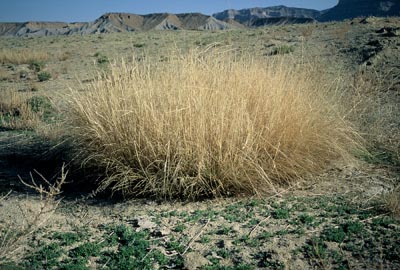Alkali Sacaton

Common Name(s):
Alkali Sacaton
Scientific Name:
Sporobolus airoides (Torr.) Torr.
Scientific Name Synonyms:
None known
Symbol:
SPAI
Description:
Life Span: Perennial
Origin: Native
Season: Warm
Growth Characteristics: A robust bunchgrass, often with stems bent outward (decumbent) at the base; forms large, tough clumps 1 ½ to 3 feet tall; coarse, glossy roots, and culms which appear to be solid, especially near the base. Reproduction is by seeds and by tillers. Starts growth early in mid-spring, flowers June until frost.
Seedhead: Spreading, pyramidal panicle-type inflorescence 4 to 16 inches long; spikelets are very small, containing one floret; seeds look like grains of brown sugar, and shatter from lemma and palea.
Leaves: Blades are long and stiff, especially when dry, and tapered to a long, often rolled point; midrib is prominent; sheath often fringed on the margins; hairy inside and near margin on outside of collar; ligules are fringes of short hairs; auricles absent.
Ecological Adaptions:
Alkali Sacaton is native to Utah and is usually found at elevations between 4200 and 6200 feet in the lowlands, floodplains, and in the drier areas such as desert valleys. Does best in areas with 12 to 18 inches of annual precipitation or equivalent in run-in water. It is common in the stream channels with alkaline soils. It withstands flooding and considerable soil deposition, and may occur in nearly pure stands.
Soils: Alkaline or saline soils in meadows and valleys, or sandy soils of desert foothills or roadsides, and dry and gravelly slopes. It is most abundant on moderately moist alkaline soils of bottomlands where other species are not adapted. Also abundant in areas where there are accumulations of run-in water at intervals during the growing season.
Associated Species: Western wheatgrass, squirreltail, rabbitbrush, saltbushes, saltgrass, and greasewood.
Uses and Management:
Alkali sacaton is an excellent grass for erosion control. It is fair to good forage for cattle and horse, poor for sheep and wildlife while actively growing, poor for all animals when dry, makes fair hay when cut during or before flowering.
Management should provide for grazing no more than 50 percent of the top growth during rapid growth and seed formation stage. It has a favorable influence on watersheds but requires good management.

